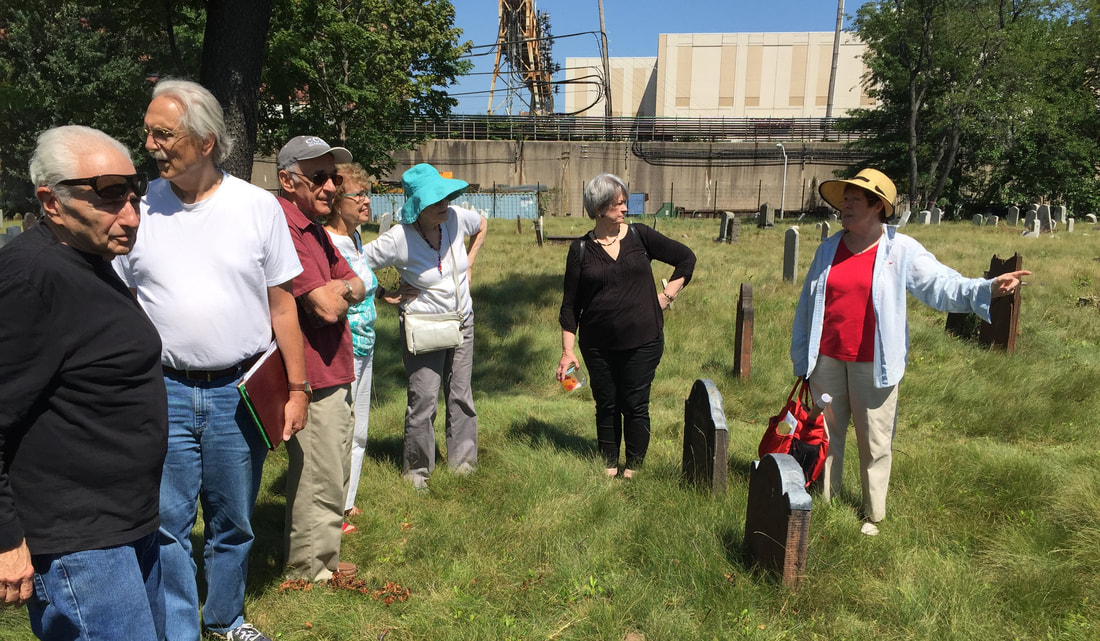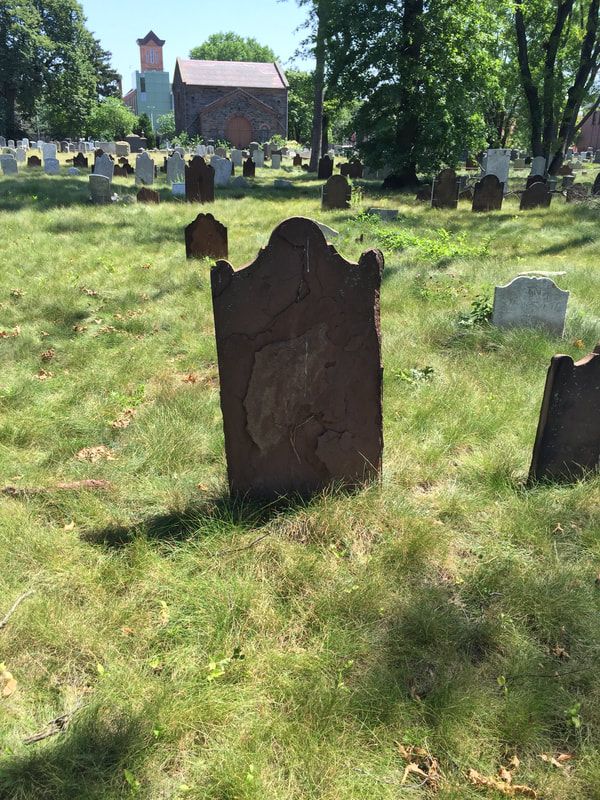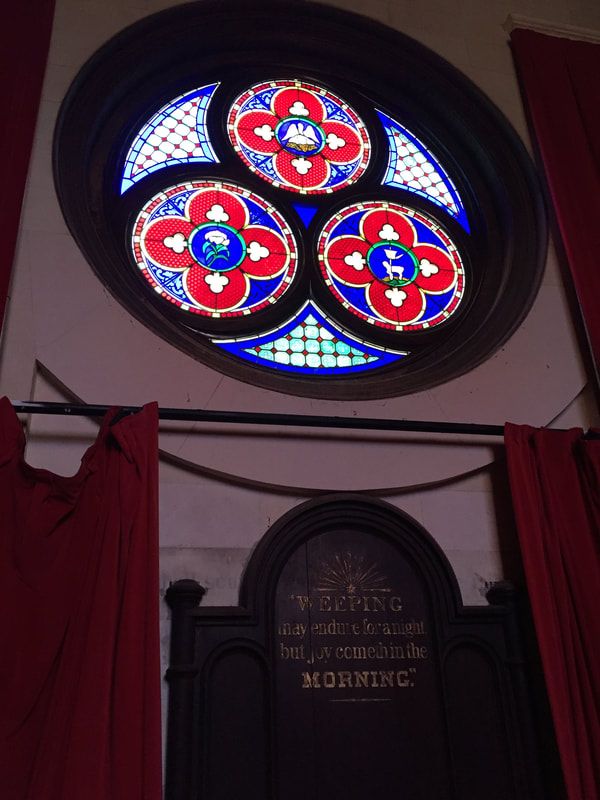 Cate Ludlam in Prospect Cemetery, Jamaica, Queens Cate Ludlam in Prospect Cemetery, Jamaica, Queens Before the summer totally gets away, I need to write about one of my loveliest outings of recent months – a visit to a historic cemetery I had not known existed. I went with a few history-minded friends from Jamaica High School, who are forever bonded to central Queens, where we were raised. The region goes back to Dutch and English settlers in the 17th Century, and, of course, the Jameco tribe of Native Americans, who named themselves after the Algonquin word for beavers, who were here first. We acquired our educations and lifelong friends at Jamaica High without ever knowing about Prospect Cemetery, on Beaver Road, now surrounded by York College in South Jamaica. The private cemetery is one of the oldest in New York City for English settlers. Our tour was conducted by Catherine Ludlam, who is related to other old Long Island families; (the name is sometimes spelled "Ludlum," but the original, from Matlock, Derby, England, is spelled "Ludlam.") Either way, Ludlam, a retired computer consultant, has helped revive the cemetery from the neglect and vandalism over the decades. How did old Jamaica types, now scattered in our worldwide diaspora, hear about Prospect Cemetery? The credit goes to my good friend Michael Schwab, who went to Jamaica half a decade later than I did, and is now a retired judge from the apple-and-cherry paradise of Yakima, Wash., living in Seattle. Michael and I became pals through his veneration of Joe Austin, the grand mentor to generations of basketball and baseball players at the St. Monica’s Parish. (Michael is as Jewish as the prune danish he craves on his regular homecomings to Queens.) Michael and his lovely wife Jane, of blessed memory, would seek out historic spots on visits to Queens. Across the street from where St. Monica’s (with its basement basketball court, where a player named Cuomo practiced running his defender into murderous tile pillars at center court) used to be, is the historic cemetery. Who knew? Michael Schwab became a fan of the cemetery, via Cate Ludlam, and asked me to round up a small group of Jamaica pals when he was in Queens a few weeks ago. So I rounded up history buffs -- West Side Shelley and East Side Jean and Trumpland Michael and Westchester Wally and my wife, the non-Jamaican. Cate took us first to a family chapel, built for three Ludlam sisters. During the lawless 60s and 70s, vandals delighted in shooting out the stained-glass windows, now replaced since the site was secured by the growth of York College. Next, we walked through thick grass (Eco-Lawn, a brand that needs no mowing) and Cate pointed out tombstones that told of life from one generation to the next -- no historical footnotes or explanations, just names and dates. The earliest recognizable tombstone was: for Mary Fitch: (“Died: Jan. -- (?) 1709. Age 17 years.”) Nearby in the Hariman family section was the tombstone for “Jane Lyons, a colored woman, who upwards of 65 years was a faithful and devoted domestic in the family of James Hariman, Sr. of this village, died Dec. 19, 1858. Age 75 years.” And not far away was the tombstone for James Henry Hackett, a noted Shakespearean actor who in 1863 impressed a resident of Washington, D.C., who wrote a fan letter signed “A. Lincoln.” As we trekked around the cemetery, Cate told us about her earlier explorations – the homeless man, living in the underbrush, who shocked her, and the student dig for obscured markers that ended prematurely with the discovery of the skeleton of a child – identity and cause of death, unknown. Cate mentioned the sad discovery to a relative, a writer named Cornelia Read, who subsequently included Cate in a novel called “Invisible Boy.” Nearby, we saw the weathered tombstone of Increase Carpenter -- a stunning flashback for me to the late 40s, when my class at P.S. 35 in Hollis used to take a walk to the site of the farm of Increase Carpenter, the quartermaster in the upstart militia. This farm was where Gen. Nathaniel Woodhull was captured while ferrying cattle eastward to keep them out of the hands of the British. When Woodhull refused to say "God save the king," a British soldier whacked him in the arm with a sword, and the general died of the wound. Cate Ludlam knows the details. She is a member of the Increase Carpenter chapter of the Daughters of the American Revolution. My friends are proud of our roots in a landmark public school. (The city, in all its wisdom, lost control of the school and terminated it a few years back.) In our ways, we luxuriated in being in downtown Jamaica, where the el used to run, where Gertz used to be, just south of the main line of the Long Island Rail Road, still rumbling. After the tour, we repaired to a terrific Portuguese restaurant -- A Churrasqueira -- a block from the modernized Jamaica station -- a perfect ending to the day. * * * I have barely touched the surface of Prospect Cemetery. For further information, here are a few links: Donations to maintain the cemetery may be made to: PCA ℅ Cate Ludlam, PO Box 553, Oyster Bay, NY 11771 http://www.prospectcemeteryassociation.org/ http://www.nylandmarks.org/about_us/greatest_accomplishments/prospect_cemetery/ http://www.nylandmarks.org/programs_services/loans/historic_properties_fund/projects/prospect_cemetery_revitalization_initiative http://forgotten-ny.com/2004/03/forgotten-tour-15-jamaicas-prospect-cemetery-and-king-mansion-queens/ http://www.nytimes.com/2004/03/22/nyregion/at-a-legendary-cemetery-a-rare-look-behind-the-gates.html?_r=0 http://longislandgenealogy.com/PROSPECT%20CEMETERY.pdf
Patrick Molloy
8/26/2017 11:05:49 pm
I graduated from York College and noticed the old church and adjacent cemetery. It was enclosed by a chain link fence during my time there so I never explored it.
John Molloy
8/27/2017 01:02:49 am
I remember Rufus King & Wonder Bread strolled that space with Mom in the 50's with a stroller.
George Vecsey
8/27/2017 11:25:43 am
Dear Patrick and John: my sister Janet says you are indeed from the Molloy family of Hollis, Our mom talked about her good friend Mary all the time. Great memories.
George Vecsey
8/27/2017 11:34:12 am
I should add, the nostalgia kicks in for all of us from Jamaica, when we return. The leaders of our very tight class at Jamaica, Jean White Grenning and Walter Schwartz, arranged an outing to the site of the Valencia Theater, in 2012. It is now a gospel tabernacle. Wally is still in touch with Sister Forbes, who gave us such a wonderful tour: 9/13/2017 09:45:40 pm
Thanks for your memories of Jamaica. It was the center of the universe for us, in those days. Comments are closed.
|
Categories
All
|











